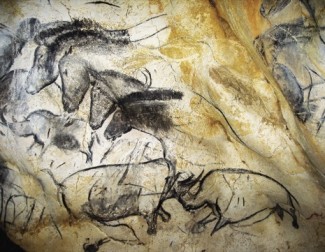The Cave of Forgotten Dreams (Werner Herzog, 2010): Canada, USA, UK, France, Germany
Reviewed by Richard Feilden. Viewed at Raleigh Studios, Hollywood.
This is it. It’s make or break time for my relationship with 3D films. We did not get off to a good start with a frankly off-putting first date. Pointy things were thrown at me, the dialog was forced and I really felt that my would-be seducer was simply going through the motions, putting on a show for me that was all sparkle with no substance. It left me feeling a little blue.
But a sultry temptress with a Bavarian accent has make me an offer I can’t refuse, promising me culture, excitement and just a little hint of crazy. So, can Cave of Forgotten Dreams thrill me, stimulate me, and take me places I’ve never been before? Or will Werner Herzog’s latest documentary reveal 3D to be no more than distracting arm-candy?
The film itself, extra-dimensional frippery aside, is a journey into the Chauvet cave, which lies in southern France. There, sealed away from the world for around twenty five thousand years, exist the earliest works of art yet discovered, most of it thirty to thirty two thousand years old. The cave’s discovery in 1994 opened up a new chapter in our knowledge of our ancestors.
Unfortunately, the very presence of people in the caves threatens the delicate impressions of ancient man that it holds. Our very breath can cause mould to grow on the walls and destroy the images. Conversely, the caves themselves are hazardous to those who explore them, as they contain dangerous levels of radon gas. For these reasons, access to the cave is strictly limited. Neither you nor I will ever get the chance to set foot on the narrow walkways to which Herzog and his team were restricted. It is for that reason that he chose to make the film in 3D, to get the audience as close to the awe inspiring experience of being there as possible.
The cave itself is the focus for a large part of the film. The images on the walls defy expectation with their complexity and beauty. In one spot a group of horses comes to life with delicate shading. In others animals are depicted with many legs, or as a series of staggered, ghostly images, lending a sense of movement to the beasts. These are not primitive scratchings, crude representations of the hunt. They truly are art. Breathtaking, beautiful art. You can hear the awe in the breathy exclamations of Herzog’s voice over, a hint of excitement revealed in his usually controlled (if you aren’t familiar with his Germanic tones, have a hunt on YouTube for the footage of him shrugging off being shot mid-interview) pronouncements. His passion is infectious, pulling you into this forbidden kingdom.
In these sections the promise of 3D comes closest to being fulfilled. The sense of depth it provides does bring the cave to life. In particular, it helps reveal the structure of the walls of the cave, which Herzog was only able to light with small LED rigs for fear of damaging the paintings. Without 3D, their undulations, often integrated into the structure of the artwork, would have been lost. It really is worth popping the glasses on for this, though there is a price to pay, above and beyond the theater’s 3D ‘tax’.
The cost is color. Now, modern polarized 3D is a long way from the red and blue filter days of the last 3D push, but you still sacrifice brightness and the true colors of the film when you go Buddy Holly. I removed the supplied specs at one point and was amazed at the brightness and whiteness of the cave wall on the screen. The parts of the shot that were at the ‘front’ of the 3D screen, and thus not distorted by overlapping images, shone with a clarity that the glasses robbed from them. Sadly, there is no solution to this with today’s technology. It’s 3D or true color – take your pick.
Once the film takes us out of the cave itself, the 3D becomes distraction once more. It simply isn’t necessary to show us someone’s 2D computer screen in 3D! There are also some problems with fine detail, where thin objects (the branches of a bush for example) shimmer on the screen as the cameras struggle to resolve them. It does however give Herzog a chance to poke a little fun at the usual 3D fare though, as well as demonstrate his unerring ability to find the crazy (suicidal penguins, Klaus Kinski) out there. As a college professor ineptly attempts to demonstrate a Paleolithic spear throwing technique (it’d would be much more impressive, he urges, in the hands of a skilled hunter!) you can imagine Herzog’s glee. “Look”, he seems to be chiding Hollywood’s directors, “I too can throw pointy things around in 3D. But doesn’t it look ridiculous?”
So this wasn’t a perfect date then, but close enough. To be honest, I never expected anything less from Herzog. Yes, the film goes ‘full Herzog’ in the closing moments (what would albino crocodiles make of the caves?), but that won’t be what you remember when you walk out into the sunlight. Nor will it be the bumbling professor hurling sticks in a field. It will be the magical Chauvet cave, frozen in time, hidden from sight, illuminated by Herzog.
This film was screened for the press.
About this entry
You’re currently reading “The Cave of Forgotten Dreams (Werner Herzog, 2010): Canada, USA, UK, France, Germany,” an entry on Student Film Reviews
- Published:
- 04.29.11 / 9pm
- Category:
- Documentary, Films

1 Comment
Jump to comment form | comments rss [?] | trackback uri [?]